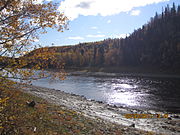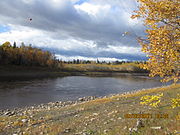Fort Liard
Fort Liard
Echaot'l Koe or Acho Dene Kue | |
|---|---|
 The Sleeping Giant - the view from the top of the hill heading into the Hamlet | |
| Coordinates: 60°14′27″N 123°28′11″W / 60.24083°N 123.46972°W | |
| Country | Canada |
| Territory | Northwest Territories |
| Region | Dehcho Region |
| Constituency | Nahendeh |
| Census division | Region 4 |
| Incorporated (hamlet) | 1 April 1987 |
| Government | |
| • Mayor | Genevieve McLeod |
| • Senior Administrative Officer | Mike Rudkin |
| • MLA | Shane Thompson |
| Area | |
| • Land | 68.38 km2 (26.40 sq mi) |
| Elevation | 216 m (709 ft) |
| Population (2016)[1] | |
| • Total | 500 |
| • Density | 7.3/km2 (19/sq mi) |
| Time zone | UTC−07:00 (MST) |
| • Summer (DST) | UTC−06:00 (MDT) |
| Canadian Postal code | X0G 0A0 |
| Area code | 867 |
| Telephone exchange | 770 |
| - Living cost | 142.5A |
| - Food price index | 139.6B |
| Website | www.fortliard.com |
| Sources: Department of Municipal and Community Affairs,[2] Prince of Wales Northern Heritage Centre,[3] Canada Flight Supplement[4] ^A 2013 figure based on Edmonton = 100[5] ^B 2017 figure based on Yellowknife = 100[5] | |
Fort Liard /liˈɑːrd/ (Slavey language: Echaot'l Koe[pronunciation?] "people from the land of the giants" or Acho Dene Kue) is a hamlet in the Dehcho Region of the Northwest Territories, Canada. It is located 37 km (23 mi) north of the British Columbia border. It became accessible by road in 1984 with the completion of the Liard Highway (Northwest Territories Highway 7 and British Columbia Highway 77).
The Hamlet of Fort Liard has two stores to choose from: The General Store and The North West Company store. It has a school "Echo Dene School", with a student population of about 150 from K-12. It also has a community health centre with four nurses, a Royal Canadian Mounted Police detachment with four members, and a recreation centre (complete with a swimming pool, skating rink, youth centre and a multi-court).[6] There is a fuel centre that sells gasoline, diesel fuel, propane, emergency survival kits and convenience items. There is also a traditional craft store which sells locally made craft items.
Demographics
Population is 500 according to the 2016 Census a decrease of 6.7% from 2011. In the 2006 Census the majority of the population, 445 people out of a total of 500, were Indigenous, either First Nations or Métis.[1] In 2017 the Government of the Northwest Territories reported that the population was 658 with an average yearly growth rate of 1.2% from 2007.[5]
|
| ||||||||||||||||||||||||||||||||||||||||||||||||||||||||||||||||||||||||
| Sources: NWT Bureau of Statistics (2001 - 2017)[7] | |||||||||||||||||||||||||||||||||||||||||||||||||||||||||||||||||||||||||
First Nations
The Dene of the community are represented by the Acho Dene Koe Band and the Métis by Fort Liard Metis Local 67. Both groups belong to the Deh Cho First Nations Tribal Council.[8][9]
Gallery
Climate
Fort Liard has a borderline subarctic climate (Köppen climate classification Dfc), just short of a humid continental climate (Köppen climate classification Dfb), characterized by extreme variation of temperatures between seasons. Temperatures can be very warm in the summer, and very cold in the winter.
The highest temperature ever recorded in Fort Liard was 35.2 °C (95.4 °F) on 13 July 2014.[10] The coldest temperature ever recorded was −46.7 °C (−52 °F) on 15 January 1974.[11]
| Climate data for Fort Liard Airport, 1981–2010 normals, extremes 1973–present | |||||||||||||
|---|---|---|---|---|---|---|---|---|---|---|---|---|---|
| Month | Jan | Feb | Mar | Apr | May | Jun | Jul | Aug | Sep | Oct | Nov | Dec | Year |
| Record high humidex | 7.3 | 14.2 | 18.1 | 23.2 | 29.7 | 37.8 | 38.8 | 37.5 | 30.9 | 24.5 | 9.4 | 14.6 | 38.8 |
| Record high °C (°F) | 14.8 (58.6) |
15.0 (59.0) |
19.9 (67.8) |
25.0 (77.0) |
32.6 (90.7) |
32.9 (91.2) |
35.2 (95.4) |
34.9 (94.8) |
30.5 (86.9) |
26.5 (79.7) |
13.5 (56.3) |
15.3 (59.5) |
35.2 (95.4) |
| Mean daily maximum °C (°F) | −17.9 (−0.2) |
−11.8 (10.8) |
−3.0 (26.6) |
8.6 (47.5) |
16.5 (61.7) |
22.2 (72.0) |
23.3 (73.9) |
21.4 (70.5) |
15.2 (59.4) |
3.9 (39.0) |
−10.6 (12.9) |
−15.4 (4.3) |
4.4 (39.9) |
| Daily mean °C (°F) | −21.8 (−7.2) |
−17.1 (1.2) |
−9.5 (14.9) |
2.0 (35.6) |
9.8 (49.6) |
15.6 (60.1) |
17.3 (63.1) |
15.3 (59.5) |
9.6 (49.3) |
0.0 (32.0) |
−14.0 (6.8) |
−19.1 (−2.4) |
−1.0 (30.2) |
| Mean daily minimum °C (°F) | −25.5 (−13.9) |
−22.3 (−8.1) |
−15.9 (3.4) |
−4.6 (23.7) |
3.0 (37.4) |
8.9 (48.0) |
11.3 (52.3) |
9.1 (48.4) |
3.9 (39.0) |
−3.9 (25.0) |
−17.4 (0.7) |
−22.7 (−8.9) |
−6.4 (20.5) |
| Record low °C (°F) | −46.7 (−52.1) |
−44.0 (−47.2) |
−39.8 (−39.6) |
−31.6 (−24.9) |
−14.5 (5.9) |
−1.6 (29.1) |
−0.1 (31.8) |
−1.7 (28.9) |
−11.7 (10.9) |
−30.0 (−22.0) |
−43.0 (−45.4) |
−45.0 (−49.0) |
−46.7 (−52.1) |
| Record low wind chill | −62.9 | −51.9 | −48.1 | −36.0 | −17.6 | 0.0 | 0.0 | −2.7 | −17.0 | −32.8 | −53.5 | −55.3 | −62.9 |
| Average precipitation mm (inches) | 24.9 (0.98) |
19.7 (0.78) |
16.2 (0.64) |
23.0 (0.91) |
41.4 (1.63) |
59.5 (2.34) |
83.4 (3.28) |
55.3 (2.18) |
44.0 (1.73) |
34.7 (1.37) |
28.4 (1.12) |
21.2 (0.83) |
451.7 (17.78) |
| Average rainfall mm (inches) | 0.0 (0.0) |
0.0 (0.0) |
0.0 (0.0) |
5.5 (0.22) |
37.7 (1.48) |
59.5 (2.34) |
83.4 (3.28) |
55.0 (2.17) |
41.4 (1.63) |
11.6 (0.46) |
0.1 (0.00) |
0.0 (0.0) |
294.1 (11.58) |
| Average snowfall cm (inches) | 26.3 (10.4) |
21.3 (8.4) |
16.8 (6.6) |
17.9 (7.0) |
3.8 (1.5) |
0.0 (0.0) |
0.0 (0.0) |
0.2 (0.1) |
2.7 (1.1) |
23.5 (9.3) |
30.3 (11.9) |
22.5 (8.9) |
165.4 (65.1) |
| Average precipitation days (≥ 0.2 mm) | 8.0 | 7.0 | 6.4 | 5.2 | 9.6 | 9.6 | 12.0 | 10.7 | 10.1 | 8.8 | 9.6 | 6.7 | 103.7 |
| Average rainy days (≥ 0.2 mm) | 0.0 | 0.0 | 0.0 | 2.0 | 8.6 | 9.6 | 12.0 | 10.7 | 9.6 | 3.7 | 0.1 | 0.0 | 56.4 |
| Average snowy days (≥ 0.2 cm) | 8.1 | 7.0 | 6.5 | 3.7 | 1.4 | 0.0 | 0.0 | 0.1 | 0.7 | 6.0 | 9.6 | 6.7 | 49.7 |
| Source: Environment Canada[11][12][13][14][15][16][10][17][18][19] | |||||||||||||
See also
References
- ^ a b c "Census Profile, 2016 Census". Statistics Canada. 21 July 2017.
- ^ "NWT Communities - Fort Liard". Government of the Northwest Territories: Department of Municipal and Community Affairs. Retrieved 13 January 2014.
- ^ "Northwest Territories Official Community Names and Pronunciation Guide". Prince of Wales Northern Heritage Centre. Yellowknife: Education, Culture and Employment, Government of the Northwest Territories. Archived from the original on 13 January 2016. Retrieved 13 January 2016.
- ^ Canada Flight Supplement. Effective 0901Z 16 July 2020 to 0901Z 10 September 2020.
- ^ a b c "Fort Liard - Statistical Profile (2006-2017)" (PDF). NWT Bureau of Statistics. Archived (PDF) from the original on 29 August 2018.
- ^ Infrastructure
- ^ Population Estimates By Community from the GNWT
- ^ Acho Dene Koe Band Archived 2 March 2008 at the Wayback Machine
- ^ Fort Liard Métis Archived 2 March 2008 at the Wayback Machine
- ^ a b "Daily Data Report for July 2014". Canadian Climate Data. Environment Canada. Retrieved 14 May 2016.
- ^ a b "Fort Liard A". Canadian Climate Normals 1981–2010. Environment Canada. Retrieved 13 May 2016.
- ^ "Daily Data Report for August 1999". Canadian Climate Data. Environment Canada. Retrieved 28 September 2016.
- ^ "Daily Data Report for October 2003". Canadian Climate Data. Environment Canada. Retrieved 28 September 2016.
- ^ "Daily Data Report for June 2011". Canadian Climate Data. Environment Canada. Retrieved 28 September 2016.
- ^ "Daily Data Report for July 2013". Canadian Climate Data. Environment Canada. Retrieved 28 September 2016.
- ^ "Daily Data Report for January 2014". Canadian Climate Data. Environment Canada. Retrieved 28 September 2016.
- ^ "Daily Data Report for March 2016". Canadian Climate Data. Environment Canada. Retrieved 28 September 2016.
- ^ "Daily Data Report for November 2015". Canadian Climate Data. Environment Canada. Retrieved 28 September 2016.
- ^ "Daily Data Report for May 2016". Canadian Climate Data. Environment Canada. Retrieved 13 May 2016.
- ^ "Environment Canada FTP". Environment and Climate Change Canada. Government of Canada. Retrieved 3 October 2016.







